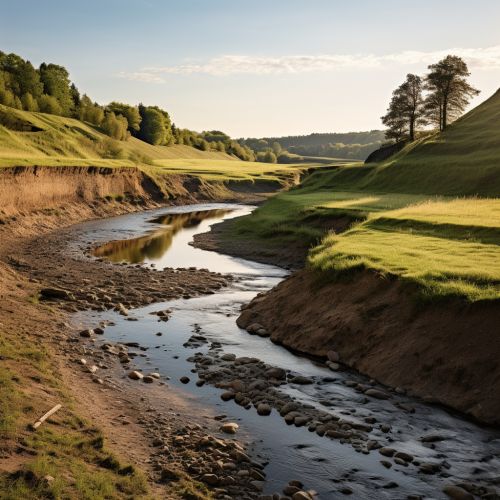Erosion Processes in River Dynamics
Introduction
Erosion is a significant aspect of river dynamics, shaping landscapes and influencing the flow and behavior of rivers. It is a complex process, involving the interaction of water, sediment, and the river's physical environment. Erosion processes in river dynamics are primarily driven by the river's flow velocity, sediment load, and the characteristics of the river's bed and banks.
Types of Erosion
There are several types of erosion that occur in river dynamics, each with their own unique characteristics and impacts.
Hydraulic Action
Hydraulic action is the process of erosion caused by the motion of water against a river's bed and banks. This process is most effective in areas where the river's velocity is high, such as in rapids or waterfalls.
Abrasion
Abrasion occurs when sediment and other material carried by the river scrape against the river's bed and banks, wearing them away. This process is also known as corrasion.
Attrition
Attrition is the process of erosion where the river's sediment particles collide with each other, breaking down into smaller, rounder particles.
Corrosion
Corrosion, or chemical erosion, occurs when the river's water chemically reacts with certain types of rock in the river's bed and banks, causing them to dissolve.
Factors Influencing Erosion
Several factors influence the rate and extent of erosion in river dynamics. These include the river's flow velocity, sediment load, and the physical and chemical characteristics of the river's bed and banks.
Flow Velocity
The flow velocity of a river is a primary driver of erosion. Higher flow velocities increase the river's ability to erode its bed and banks and carry sediment.
Sediment Load
The sediment load of a river, or the amount of sediment it carries, also influences erosion. A higher sediment load increases the river's abrasive power.
Bed and Bank Material
The material composing the river's bed and banks significantly affects erosion. Softer materials, such as sand and silt, are more easily eroded than harder materials, such as rock or clay.
River Morphology
The shape and structure of the river, or its morphology, also influences erosion. For example, rivers with steeper gradients or more irregular shapes are more prone to erosion.
Impacts of Erosion
Erosion in river dynamics has significant impacts on both the physical environment and human activities.
Physical Environment
Erosion shapes the physical environment by creating features such as valleys, gorges, and meanders. It also influences the river's flow and behavior, affecting its course, velocity, and sediment load.
Human Activities
Erosion can have both positive and negative impacts on human activities. On the positive side, erosion can create fertile alluvial soils that are beneficial for agriculture. On the negative side, erosion can cause problems such as land loss, damage to infrastructure, and water pollution.
Management of Erosion
Erosion in river dynamics can be managed through a variety of techniques, including river engineering, land use planning, and conservation practices.
See Also


